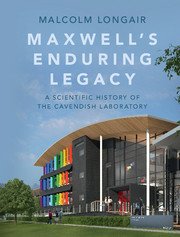Book contents
- Frontmatter
- Dedication
- Contents
- Preface
- Acknowledgements
- Part I To 1874
- Part II 1874 to 1879
- Part III 1879 to 1884
- Part IV 1884 to 1919
- Part V 1919 to 1937
- Part VI 1938 to 1953
- 11 Bragg and the war years
- 12 Bragg and the post–war years
- Part VII 1953 to 1971
- Part VIII 1971 to 1982
- Part IX 1984 to 1995
- Part X 1995 to present
- Appendix The evolution of the New Museums site
- Notes
- References
- Author index
- Subject index
12 - Bragg and the post–war years
from Part VI - 1938 to 1953
Published online by Cambridge University Press: 05 July 2016
- Frontmatter
- Dedication
- Contents
- Preface
- Acknowledgements
- Part I To 1874
- Part II 1874 to 1879
- Part III 1879 to 1884
- Part IV 1884 to 1919
- Part V 1919 to 1937
- Part VI 1938 to 1953
- 11 Bragg and the war years
- 12 Bragg and the post–war years
- Part VII 1953 to 1971
- Part VIII 1971 to 1982
- Part IX 1984 to 1995
- Part X 1995 to present
- Appendix The evolution of the New Museums site
- Notes
- References
- Author index
- Subject index
Summary
Restructuring the Laboratory: the immediate post-war years
With the end of hostilities, Bragg faced the challenge of converting the Laboratory from an organisation supporting the war effort to a physics department which had to be restructured in the light of a number of changing circumstances.
• The Austin Wing could now be returned to its original purpose, which was to relieve the serious overcrowding and lack of adequate laboratory space, a legacy of the Rutherford era.
• Just as at the end of the First World War, the demands of the Second World War had resulted in a backlog of undergraduate and postgraduate physics students to be trained in the physical sciences. In physics, the number of undergraduates was 50% greater than it had been before the war and the numbers in the final (Part II) year almost trebled to about 120. But the greatest increase was in the number of graduate students, which now totalled 160, of which 110 were studying for the PhD degree. The result was that, even with the addition of the new AustinWing, the Laboratory was already full to capacity by 1948 and indeed overcrowded in some areas (Bragg, 1948).
• The huge role which physics had played in the war, in particular in national security, meant that more physicists were needed for military and civilian research and development. The Barlow Report had recommended that there was a national need to maintain this larger number of qualified physics students. These conclusions were broadly in line with Bragg's own estimate, namely that 200 to 300 professional physicists would need to be trained each year in the UK after the war (Bragg, 1942b).
• As alluded to in Section 11.8, the physicists returned from the war with attitudes quite different from pre-war assumptions about how research should be carried out. The urgency of research and development in all areas of support for the war effort meant that physicists had become used to essentially unlimited financial and administrative support for their activities.
- Type
- Chapter
- Information
- Maxwell's Enduring LegacyA Scientific History of the Cavendish Laboratory, pp. 272 - 318Publisher: Cambridge University PressPrint publication year: 2016



